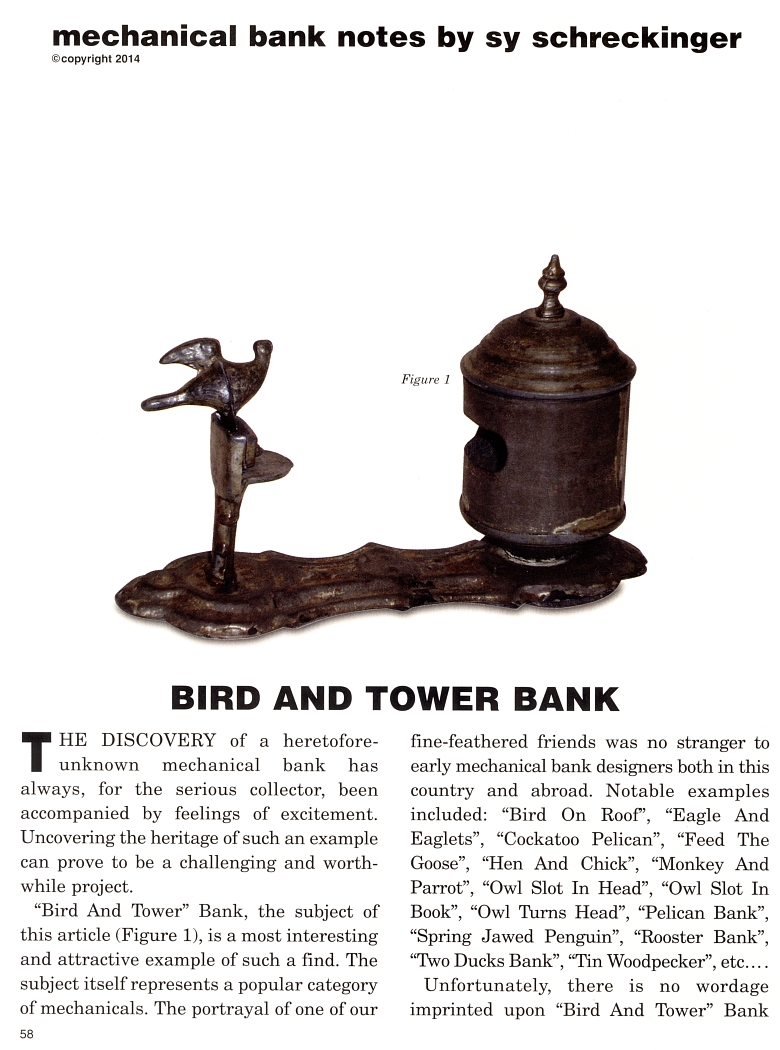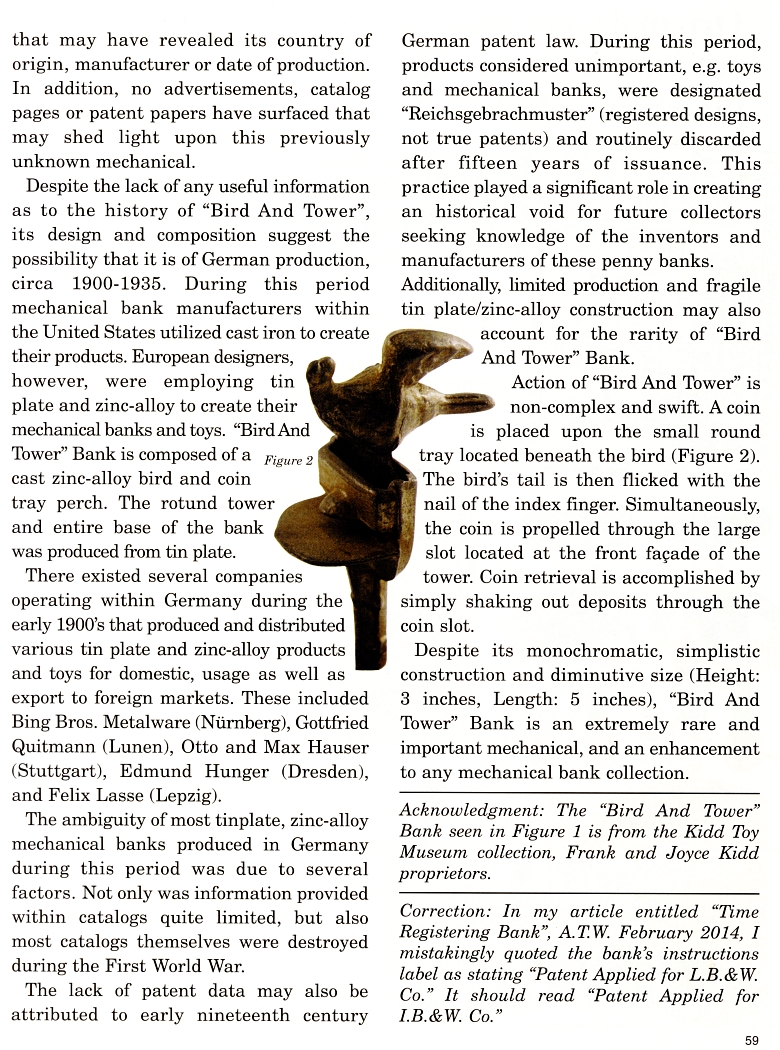|
Bird and Tower Bank
by Sy Schreckinger – ANTIQUE TOY WORLD Magazine – March, 2014
THE DISCOVERY of a heretofore unknown mechanical bank has always, for
the serious collector, been accompanied by feelings of excitement.
Uncovering the heritage of such an example can prove to be a challenging
and worthwhile project.
"Bird And Tower" Bank, the subject of this article (Figure 1), is a
most interesting and attractive example of such a find. The subject
itself represents a popular category of mechanicals. The portrayal of
one of our fine-feathered friends was no stranger to early mechanical
bank designers both in this country and abroad. Notable examples
included: "Bird On Roof', "Eagle And Eaglets", "Cockatoo Pelican", "Feed
The Goose", "Hen And Chick", "Monkey And Parrot", "Owl Slot In Head",
"Owl Slot In Book", "Owl Turns Head", "Pelican Bank", "Spring Jawed
Penguin", "Rooster Bank", "Two Ducks Bank", "Tin Woodpecker", etc....
Unfortunately, there is no wordage imprinted upon "Bird And Tower"
Bank that may have revealed its country of origin, manufacturer or date
of production. In addition, no advertisements, catalog pages or patent
papers have surfaced that may shed light upon this previously unknown
mechanical.
Despite the lack of any useful information as to the history of
"Bird And Tower", its design and composition suggest the possibility
that it is of German production, circa 1900-1935. During this period
mechanical bank manufacturers within the United States utilized cast
iron to create their products. European designers, however, were
employing tin plate and zinc-alloy to create their mechanical banks and
toys. "Bird And Tower" Bank is composed of a cast zinc-alloy bird and
coin tray perch. The rotund tower and entire base of the bank was
produced from tin plate.
There existed several companies operating within Germany during the
early 1900's that produced and distributed various tin plate and
zinc-alloy products and toys for domestic, usage as well as export to
foreign markets. These included Bing Bros. Metalware (Nurnberg),
Gottfried Quitmann (Lunen), Otto and Max Hauser (Stuttgart), Edmund
Hunger (Dresden), and Felix Lasse (Lepzig).
The ambiguity of most tinplate, zinc-alloy mechanical banks
produced in Germany during this period was due to several factors. Not
only was information provided within catalogs quite limited, but also
most catalogs themselves were destroyed during the First World War.
The lack of patent data may also be attributed to early nineteenth
century German patent law. During this period, products considered
unimportant, e.g. toys and mechanical banks, were designated "Reichsgebrachmuster"
(registered designs, not true patents) and routinely discarded after
fifteen years of issuance. This practice played a significant role in
creating an historical void for future collectors seeking knowledge of
the inventors and manufacturers of these penny banks.
Additionally, limited production and fragile tin plate/zinc-alloy
construction may also account for the rarity of "Bird And Tower" Bank.
Action of "Bird And Tower" is non-complex and swift. A coin is
placed upon the small round tray located beneath the bird (Figure 2).
The bird's tail is then flicked with the nail of the index finger.
Simultaneously, the coin is propelled through the large slot located at
the front façade of the tower. Coin retrieval is accomplished by simply
shaking out deposits through the coin slot.
Despite its monochromatic, simplistic construction and diminutive
size (Height: 3 inches, Length: 5 inches), "Bird And Tower" Bank is an
extremely rare and important mechanical, and an enhancement to any
mechanical bank collection.
Acknowledgment: The "Bird And Tower" Bank seen in Figure 1 is from
the Kidd Toy Museum collection, Frank and Joyce Kidd proprietors.
Correction: In my article entitled "Time Registering Bank", A.T.W.
February 2014, I mistakingly quoted the bank's instructions label as
stating "Patent Applied for L.B.&W. Co." It should read "Patent Applied
for LB.&W. Co." |


